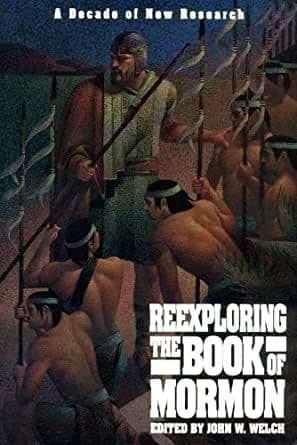Book
85 Chapters

Alma 35:16 “He caused that his sons should be gathered together, that he might give unto them every one his charge, separately.”
In August 1984 for the first time, several stunning similarities between Alma 36-42 and the traditional Israelite observance of Passover were discovered. Finding evidences of Jewish festivals in the Book of Mormon is just a small part of what promises eventually to be a meaningful study.
Passover, of course, commemorates the deliverance of the Israelites from Egypt by the power of God. As part of this celebration, fathers would gather their sons (as in Alma 35:16) in accordance with Exodus 10:2, which told the Jews “to tell in the ears of thy son, and of thy son’s son, what things I have wrought in Egypt.” Alma would have followed this rule since the Nephites “were strict in observing . . . the law of Moses” at this time (Alma 30:3).
According to traditions at least as early as the time of Christ and probably earlier,1 after gathering his family the father then instructed his sons and answered their questions. His words were not fixed but were “to fit the knowledge and understanding of the child” and were supposed “to spell out the sequence of sin, suffering, repentance, and redemption.”2 Each of Alma’s admonitions to his sons, Helaman (Alma 36-37), Shiblon (Alma 38), and Corianton (Alma 39-42), does this precisely, each in its own way.
Moreover, three Passover questions are found in the Bible. Traditionally, each of these questions was asked in turn by the sons and was answered by the father. In time, each of these questions came to be associated with a different type of son.
First, “What is the meaning of the testimonies, and the statutes, and the judgments, which the Lord our God hath commanded you?” (Deuteronomy 6:20). This question was asked at Passover by a wise son. Helaman stands as the wise son: In talking to Helaman, Alma mentions “wisdom” at least eight times in Alma 37. Notice also how Alma explains the meaning of the laws and testimonies of God as he explains the meaning of the plates of Nephi (preserved for a “wise purpose”), the twenty-four gold plates, and the Liahona in Alma 37. The Jewish father was especially expected to explain the meaning of traditional things to “future generations”3 and to use “allegorical interpretation.”4 Alma does exactly this. See Alma 37:19 (“future generations”) and Alma 37:45 (“is there not a type in this thing?”).
Second, “What mean ye by this service?” (Exodus 12:26). This question was asked by a wicked son. This son is depicted in the Jewish literature as one guilty of social crimes, who had excluded himself from the community, and believed in false doctrines. According to Jewish practice, he is to be told, in a manner that will “set his teeth on edge,” that he will be punished for his own sins, and that, had he been in Egypt, he would not have been redeemed.5 Such is unmistakably the thrust of Alma’s words to Corianton—who had left the ministry (see Alma 39:3), caused social problems (see Alma 39:11), followed false doctrines (see Alma 41:9), and is taught by his father about nothing but redemption and one’s personal suffering for sin (see Alma 41:3-4, 7).
Third, “What is this?” (Exodus 13:14), is an ambiguous question. Is it sarcastic or serious? Israelite tradition said that the uninformed son who asked this question needed to be taught the law and given preventative instruction to keep him well away from any risk of breaking the law.6 This, indeed, is what Alma tells Shiblon, as he teaches him to be diligent (see Alma 38:10) and gives him a high code of conduct (see Alma 38:11-14).
Many other Passover themes are detectable in Alma 35-42. Alma speaks of “crying out” (compare Deuteronomy 26:7; Alma 36:18) for deliverance from “affliction” (compare Deuteronomy 26:6; Alma 36:3, 27; especially the unleavened Passover “bread of affliction”) and from bondage in Egypt (Alma 36:28), from the “night of darkness” (compare Alma 41:7; Exodus 12:30), and from bitter suffering (Alma 36:18, 21; related to the Passover “bitter herbs”in Exodus 12:8). The Paschal lamb may parallel some of Alma’s references to Christ; and the hardness of Pharaoh’s heart (see Exodus 11:10) may parallel Alma’s reference to the hardness of his people’s hearts (see Alma 35:15). Just as Alma’s deliverance was preceded by three days and nights of darkness (see Alma 36:16), so was the first Passover (see Exodus 10:22).
Although still tentative, the proposition is already quite intriguing, if not compelling: Alma’s messages to his three sons were spoken in conjunction with a Nephite observance of the feast of the Passover.
Based on research by Gordon C. Thomasson and John W. Welch, August 1984. For further research regarding Israelite festivals in the Book of Mormon, see pages 117-19 and 135-41 in this book.
1. See Abraham P. Bloch, The Biblical and Historical Background of the Jewish Holy Days (New York: KTAV, 1978), 128-33.
2. Ibid., 131-32.
3. Ibid., 153.
4. Ibid., 157.
5. See ibid., 159-63.
6. See ibid., 163-64.
Book
85 Chapters
Items in the BMC Archive are made publicly available for non-commercial, private use. Inclusion within the BMC Archive does not imply endorsement. Items do not represent the official views of The Church of Jesus Christ of Latter-day Saints or of Book of Mormon Central.